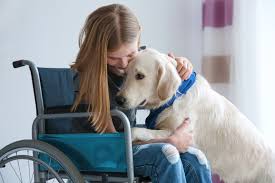The Healing Power of Psychiatric Therapy Dogs
Psychiatric therapy dogs, also known as emotional support animals, play a crucial role in supporting individuals with mental health conditions. These specially trained dogs provide comfort, companionship, and emotional support to their owners, helping them cope with the challenges of their conditions.
Research has shown that interacting with therapy dogs can reduce anxiety, lower blood pressure, and improve overall mood. For individuals struggling with conditions such as depression, PTSD, or anxiety disorders, the presence of a therapy dog can be incredibly beneficial in managing symptoms and promoting emotional well-being.
Unlike service dogs, psychiatric therapy dogs do not require specific training to perform tasks related to a disability. Instead, their primary role is to provide emotional support through their presence and companionship. This can be particularly helpful for individuals who may feel isolated or overwhelmed by their condition.
Therapy dogs are often used in clinical settings such as hospitals, nursing homes, and mental health facilities to provide comfort to patients during difficult times. They are also increasingly being incorporated into individual therapy sessions to help clients feel more at ease and open up about their emotions.
It is important to note that psychiatric therapy dogs are not considered service animals under the law and do not have the same rights of access as service dogs. However, many establishments recognise the value of therapy dogs and welcome them in certain settings to provide support to those in need.
In conclusion, psychiatric therapy dogs offer a unique form of support for individuals struggling with mental health conditions. Their unconditional love and calming presence have a profound impact on the well-being of their owners, providing comfort and solace during challenging times.
Essential Tips for Integrating Psychiatric Therapy Dogs into Healthcare Settings
- Ensure the therapy dog is well-trained and certified for its role.
- Create a calm and welcoming environment for both the dog and the patients.
- Establish boundaries to ensure the safety and well-being of everyone involved.
- Encourage interaction between the therapy dog, patients, and healthcare professionals.
- Regularly assess the therapy dog’s health and temperament to maintain effectiveness.
- Provide proper care, grooming, exercise, and rest for the therapy dog.
Ensure the therapy dog is well-trained and certified for its role.
It is crucial to ensure that the psychiatric therapy dog is well-trained and certified for its role in providing emotional support. A properly trained therapy dog will have the necessary skills and temperament to interact safely and effectively with individuals who may be experiencing mental health challenges. Certification ensures that the dog has undergone appropriate training to handle various situations and environments with sensitivity and professionalism, ultimately enhancing the quality of support it can offer to those in need.
Create a calm and welcoming environment for both the dog and the patients.
To ensure the effectiveness of psychiatric therapy dogs, it is essential to create a calm and welcoming environment that benefits both the dog and the patients. A serene atmosphere can help reduce stress and anxiety for all involved, promoting a sense of comfort and security. By maintaining a peaceful setting, free from distractions and loud noises, the therapy dog can better focus on providing emotional support to patients in need. Additionally, patients are more likely to feel at ease and open up emotionally when they are in a relaxed environment, enhancing the therapeutic benefits of the interaction with the therapy dog.
Establish boundaries to ensure the safety and well-being of everyone involved.
It is essential to establish boundaries when incorporating a psychiatric therapy dog into a treatment plan to safeguard the safety and well-being of all individuals involved. Clear guidelines help define the roles and responsibilities of both the handler and the therapy dog, ensuring that interactions are positive and beneficial. Setting boundaries also helps prevent any potential misunderstandings or conflicts, promoting a harmonious and effective therapeutic environment for both the individual receiving support and the therapy dog.
Encourage interaction between the therapy dog, patients, and healthcare professionals.
Encouraging interaction between the therapy dog, patients, and healthcare professionals can create a nurturing and supportive environment that fosters emotional well-being and connection. The presence of the therapy dog can help break down barriers, promote relaxation, and encourage communication among all individuals involved. Patients may feel more at ease opening up about their feelings and experiences, while healthcare professionals can benefit from the therapeutic effects of interacting with the dog. This collaborative approach enhances the overall effectiveness of psychiatric therapy dog interventions and contributes to a more positive and healing experience for everyone involved.
Regularly assess the therapy dog’s health and temperament to maintain effectiveness.
Regularly assessing the health and temperament of a psychiatric therapy dog is essential to ensure its effectiveness in providing support to individuals with mental health conditions. By monitoring the dog’s physical well-being and behaviour, handlers can address any potential issues promptly and make necessary adjustments to maintain the dog’s ability to offer comfort and companionship. A healthy and well-balanced therapy dog is better equipped to fulfil its role in promoting emotional well-being and helping those in need navigate their mental health challenges with greater ease.
Provide proper care, grooming, exercise, and rest for the therapy dog.
To ensure the well-being and effectiveness of a psychiatric therapy dog, it is essential to provide proper care, grooming, exercise, and rest. Regular grooming not only keeps the dog clean and healthy but also strengthens the bond between the dog and its owner. Adequate exercise is crucial for maintaining the dog’s physical health and mental stimulation. It is important to engage in activities that cater to the dog’s needs and energy levels. Additionally, allowing the therapy dog to rest and recharge is vital for its overall health and ability to provide support effectively. By prioritising these aspects of care, owners can ensure that their therapy dog remains happy, healthy, and ready to offer comfort and companionship when needed.

